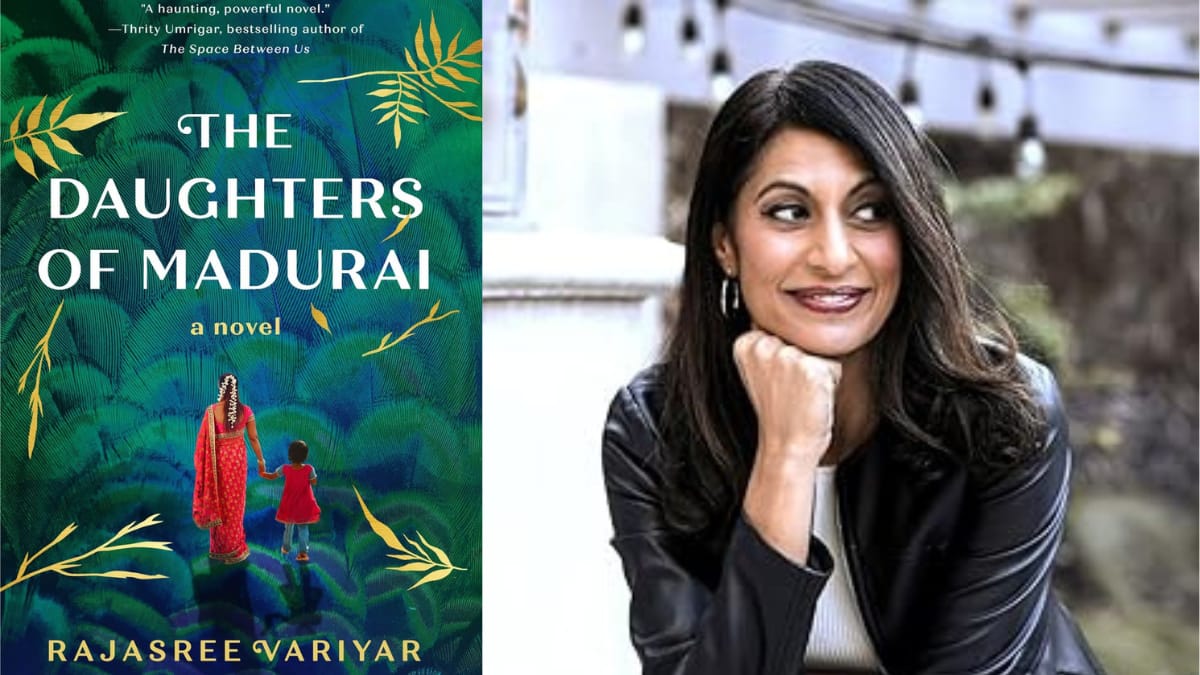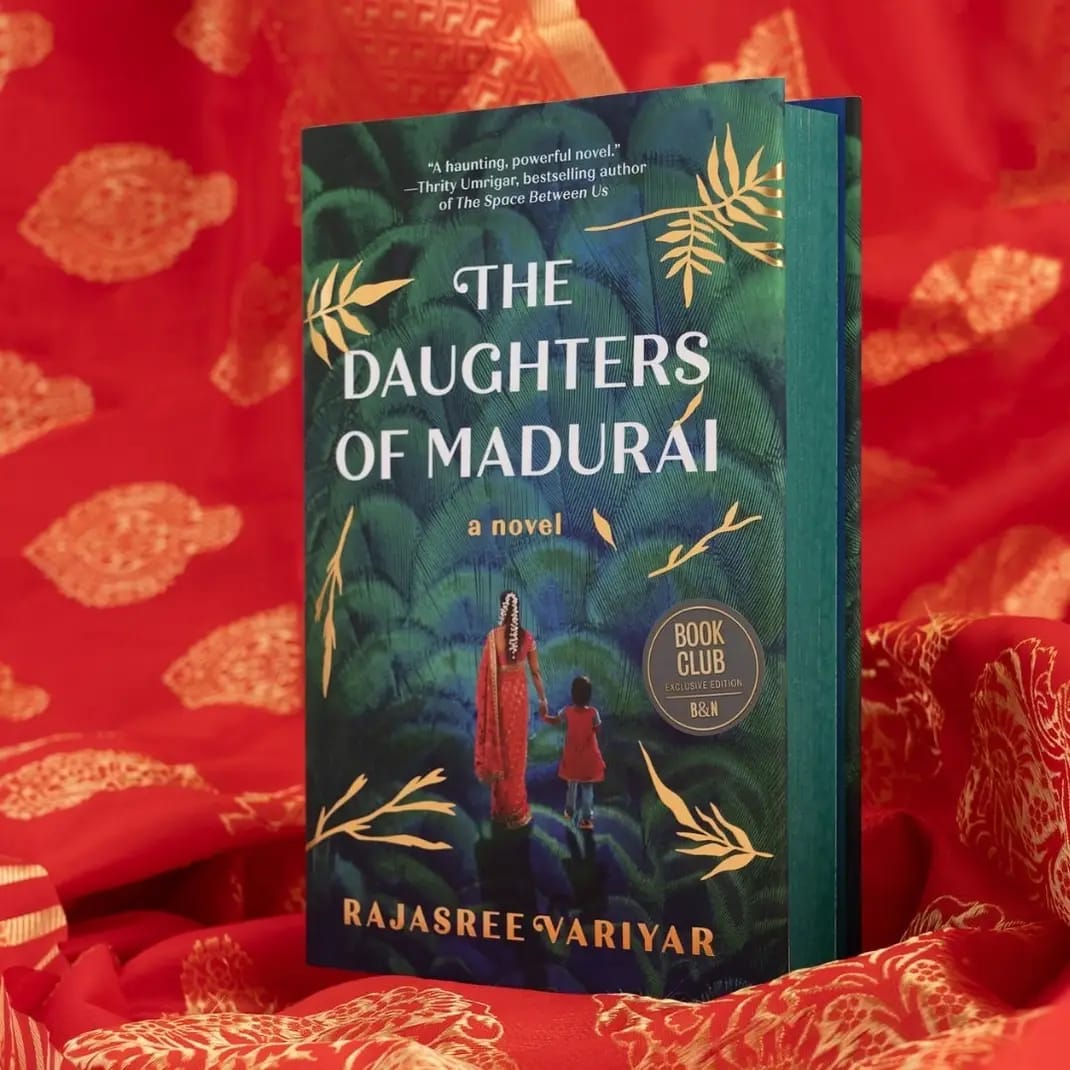The Daughters of Madurai by Rajasree Variyar is a touching tale of love, loss, and strength. As a Tamilian myself, I was excited to read this book set in the 90s in the cozy temple town of Madurai, Tamil Nadu, and this book did not disappoint with its aesthetic descriptions of the town and its people. But the message the book conveyed was far more intricate than what any reader can imagine.
The Daughters of Madurai travels along two parallel storylines, one of Janani in 1990, and the other of her daughter Nila in 2019.
The Daughters of Madurai travels along two parallel storylines, one of Janani in 1990, and the other of her daughter Nila in 2019. Janani has already given birth to three daughters. Her mother-in-law, Vandana, after letting her keep the first child Lavanika, kills the other two children as soon as they are born, against Janani’s will. She often chides Janani for her “inability to produce a boy”, calling her stupid and useless, and burdening her with household work even as she recovers from her last childbirth and the pain of losing a child.
Her husband Darshan, an alcoholic, does not interfere and often goes away for work. Now pregnant again, Janani worries about the fate of her child and prays for it to be a boy. When the midwife tells her that it is a girl, she is ashamed of her prayer and desperately wants to keep the child and is determined to do whatever it takes to fight for her unborn daughter.
On the other hand, there is the story of Janani’s adult daughter Nila set in 2019. Nila is a successful physiotherapist who lives with her parents and her brother Rohan in Sydney. To Nila’s dismay, Janani deflects all of her children’s questions about her dark past, and Nila longs to understand her mother better and to get to know her side of the family. When they hear her grandfather is unwell, they travel to India where the truth is exposed and Nila learns about her past. She sees how her mother fought to save her, and what it cost her.
Treatment of the theme of female infanticide in The Daughters of Madurai
The Daughters of Madurai explores the difficult theme of female infanticide, opening with a powerful line that captures the prejudices of several Indian families in the 90s, ‘A girl is a burden. A girl is a curse.’ Since the 1990s, it is estimated that over 500,000 baby girls have been killed and more than ten million female foetuses have been killed in India. Thankfully, the numbers have reduced drastically over the years. However, regressive attitudes have not changed, and the book’s opening line continues to be an opinion that many Indians hold on to.
Sons are seen as an investment, and daughters as a burden due to the hefty dowry that is to be paid at the wedding. The author points out that although the term “dowry” is rarely used these days, it has been replaced by “gifts” given to the groom and his family, such as gold, cars, or even houses. In The Daughters of Madurai, the contrast drawn between Nila and Janani shows the importance of education in empowering women.
Nila is strong and brave like her mother, but she has the resources and support to pursue the life of her choice. Janani, on the other hand, lives like a slave in her own home, constantly under the scrutiny of her mother-in-law and unable to make her own decisions. She even has to hide the meagre income she gets from her tailoring services, knowing her mother-in-law would not approve. On the other hand, Nila’s education gives her a chance to make a living and support herself. She lives with her parents but does not need to depend on them financially.
When Janani takes Nila to see Darshan and Vandana in 2019, they still live in the same house and are very poor. Far from feeling remorseful on seeing Nila, Darshan boasts that his second wife was able to give him two sons. And ironically, Vandana asks Nila for financial support, playing the emotional grandmother card, although she was ready to kill Nila as an infant, seeing her as a financial burden for the family. This moment shows the society’s ignorance in seeing women as a burden when we foolishly refuse to give women the resources they need to grow.
Depiction of progressive men in The Daughters of Madurai
The presentation of the character of Sanjay, Janani’s childhood friend and present employer, offers a sharp contrast from Janani’s husband, Darshan. Janani’s mother had worked as a housemaid for Sanjay’s family since Sanjay and Janani were children, when they became close friends as Janani visited Sanjay’s house every evening with her mother. While Sanjay continues his studies, graduating from IIT Bombay, Janani is forced to drop out of school and take her mother’s job as the family’s housemaid.
While Sanjay continues his studies, graduating from IIT Bombay, Janani is forced to drop out of school and take her mother’s job as the family’s housemaid.
Despite their growing feelings for one another, Sanjay maintains a respectful distance from Janani since she is married and already has a family. But this doesn’t stop him from showering kindness on her and her daughter, and standing by her as she faces several injustices, even when his own family tries to stop him. Sanjay refuses to see Janani as a servant and only treats her as a friend, encouraging her to follow her dreams and build her career in sewing.
The power of female friendships and role models
Another interesting element of The Daughters of Madurai are the strong female friendships it portrays and women supporting each other. One example is the friendship of Janani and Shubha. Both women have gone through the pain of separation from a child after birth, and support each other through it all. When Janani decides to leave home, Shubha gives her a place to stay and work and tries her best to make Janani feel at home.
Although most characters in The Daughters of Madurai have regressive attitudes, the author makes sure to include strong and inspirational older women who serve as a role model for Janani and help her out of her difficult situation. This is apparent in the character of Kamala Amma, a strong, old midwife who stands up for the women in the town and protects them, ignoring the various rumors spread about her, as well as in the character Priya Amma, Sanjay’s maternal aunt. Priya Amma rescues Janani with Sanjay’s help after Nila is born and looks after her. She also goes with Janani to her house to collect her belongings before leaving.
The Daughters of Madurai is a very powerful story that handles difficult themes without reluctance, and gives readers a raw and unfiltered experience. It might be easy to say the book holds no relevance in today’s society given that the issue of female infanticide has nearly disappeared, but this is far from reality.
The Daughters of Madurai will continue to be relevant to us as long as women continue to be oppressed and girl children are seen as unwanted or useless, and as long as families choose to educate their sons and teach their daughters to do household work. Feminism has not yet accomplished its objective until every woman can survive independently in an equal world.
Feminism has not yet accomplished its objective until every woman can survive independently in an equal world.
The Daughters of Madurai exposes the flaws in our society, but also gives us hope that things can and will get better if we choose to take the difficult path and fight for the people we love. A quote that is sure to resonate with readers is, ‘Pain is inevitable. Suffering is optional.’
Janani’s journey from living in an abusive, toxic household to providing a better life for her daughter takes the reader on an emotional ride, showing us how she uses her pain as fuel instead of suffering. Delving into themes of feminism, humanity, friendship, and love, the story shows how compassion can triumph over class differences and cruelty.








This title tackles a delicate and important subject. It emphasizes how persistently relevant female infanticide is as a social problem, particularly in settings where gender bias still exists. By placing it within the context of a conversation about “The Daughters of Madurai,” it alludes to a literary or cultural investigation, which may be a powerful means of bringing attention to and encouraging debate of this important human rights issue.